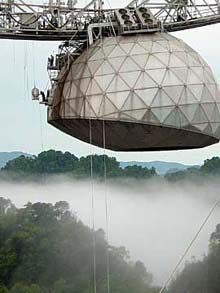Arecibo radiotelescope made incredibly more sensitive

As morning mist blankets the Puerto Rico hills, workers prepare to bring the ALFA unit (hanging from a cable at the left) into the Arecibo telescope’s Gregorian dome. Tony Acevedo/Arecibo ObservatoryCopyright © Cornell University
The Arecibo Observatory telescope, the largest and most sensitive single dish radio telescope in the world, is about to get a good deal more sensitive
Today (Wednesday, April 21) the telescope got a new “eye on the sky” that will turn the huge dish, operated by Cornell University for the National Science Foundation, into the equivalent of a seven-pixel radio camera.
The complex new addition to the Arecibo telescope was hauled 150 meters (492 feet) above the telescope’s 1,000-foot-diameter (305 meters) reflector dish starting in the early morning hours. The device, the size of a washing machine, took 30 minutes to reach a platform inside the suspended Gregorian dome, where ultimately it will be cooled and then connected to a fiber optic transmission system leading to ultra-high speed digital signal processors. The new instrument is called ALFA (for Arecibo L-Band Feed Array) and is essentially a camera for making radio pictures of the sky. ALFA will conduct large-scale sky surveys with unprecedented sensitivity, enabling astronomers to collect data about seven times faster than at present, giving the telescope an even broader appeal to astronomers.
The ALFA receiver was built by the Australian research group, Commonwealth Scientific & Industrial Research Organisation, under contract to the National Astronomy and Ionosphere Center (NAIC) at Cornell, in Ithaca, N.Y. Development of ALFA was overseen by the observatory’s technical staff. The rest of the ALFA system, including ultra-fast data processing machines, are under development at NAIC.
Radio telescopes traditionally have been limited to seeing just one spot — a single pixel — on the sky at once. Pictures of the sky have been built up by painstakingly imaging one spot after another. But ALFA lets the telescope see seven spots — seven pixels — on the sky at once, slashing the time needed to make all-sky surveys. Steve Torchinsky, ALFA project manager at Arecibo Observatory, says the new device will make it possible to find many new fast-spinning, highly dense stars called pulsars and will improve the chances of picking up very rare kinds of systems — for instance, a pulsar orbiting a black hole.
It also will map the neutral hydrogen gas in our galaxy, the Milky Way, as well as in other galaxies. Hydrogen is the most abundant element in the universe. “A whole range of science is planned for ALFA, ” says Torchinsky. “Arecibo’s large collecting area is particularly well-suited to pulsar studies.”
NAIC commissioned CSIRO to build ALFA following the success of a ground-breaking “multibeam” instrument it had designed and built for the Parkes radio telescope in eastern Australia. That instrument increased the Parkes telescope’s view 13-fold, making it practical for the first time to search the whole sky for faint and hidden galaxies.
Media Contact
More Information:
http://www.news.cornell.edu/releases/April04/Arecibo.Eye.deb.htmlAll latest news from the category: Physics and Astronomy
This area deals with the fundamental laws and building blocks of nature and how they interact, the properties and the behavior of matter, and research into space and time and their structures.
innovations-report provides in-depth reports and articles on subjects such as astrophysics, laser technologies, nuclear, quantum, particle and solid-state physics, nanotechnologies, planetary research and findings (Mars, Venus) and developments related to the Hubble Telescope.
Newest articles

Trotting robots reveal emergence of animal gait transitions
A four-legged robot trained with machine learning by EPFL researchers has learned to avoid falls by spontaneously switching between walking, trotting, and pronking – a milestone for roboticists as well…

Innovation promises to prevent power pole-top fires
Engineers in Australia have found a new way to make power-pole insulators resistant to fire and electrical sparking, promising to prevent dangerous pole-top fires and reduce blackouts. Pole-top fires pose…

Possible alternative to antibiotics produced by bacteria
Antibacterial substance from staphylococci discovered with new mechanism of action against natural competitors. Many bacteria produce substances to gain an advantage over competitors in their highly competitive natural environment. Researchers…





















